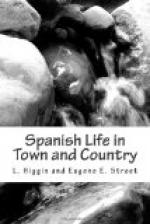A curious feature of Spanish country life to us are the goatherds. Where the large flocks of goats about Madrid pasture, I know not; but I have often seen them coming home in the evening to be milked, or starting out in the morning. The goatherd, clad in his manta, and carrying a long wand of office over his shoulder, and I think also a horn, stalks majestically along with all the dignity of a royal marshal of processions, and the goats follow him, with a good deal of lagging behind for play, or nibbling, if they should chance to see anything green. Still, they scamper after their generalissimo in the end, and meanwhile he is much too dignified to look back. Taking advantage of this, I have seen women come out of their cottages on the roadside and milk a goat or two as it passed; and from the way the animal made a full stop, and lent itself to the fraud—if such it were—it was evidently a daily occurrence.
In times not long past, if indeed they do not still exist, the dust-heaps outside Madrid were the homes of packs of lean, hungry dogs, great brindled creatures of the breed to be seen in Velasquez pictures; these animals prowled about the streets of Madrid in the early morning, acting as scavengers. When they became too numerous, the civil guards laid poison about at night in the dust-heaps before the houses, and the very early riser might see four or five of these great creatures lying dead on the carts which collect the refuse of Madrid before the world in general is astir. These wild dogs were disagreeable customers to meet when riding outside the city, until we learned to avoid the localities where they spent their days, for they would give chase to the horses if they caught sight of them, and the only thing to be done was to remain perfectly quiet until they tired of barking and returned to the dust-hills to resume their search for food.




